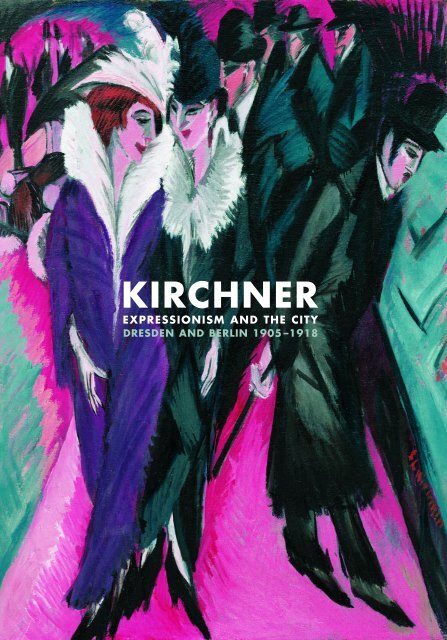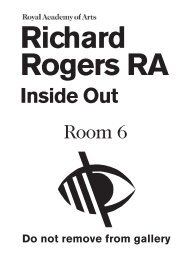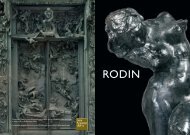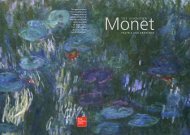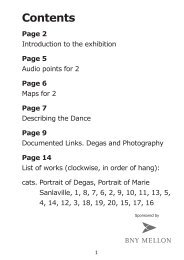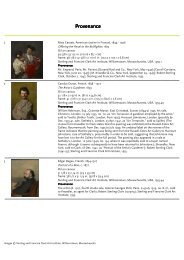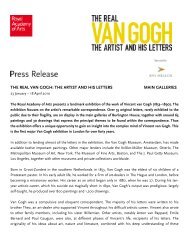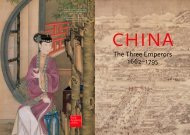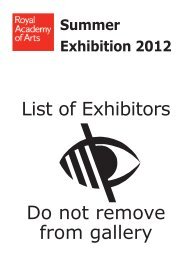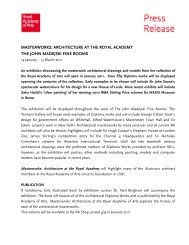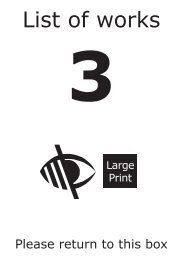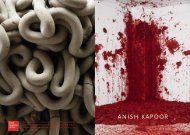KIRCHNER - Royal Academy of Arts
KIRCHNER - Royal Academy of Arts
KIRCHNER - Royal Academy of Arts
Create successful ePaper yourself
Turn your PDF publications into a flip-book with our unique Google optimized e-Paper software.
<strong>KIRCHNER</strong><br />
EXPRESSIONISM AND THE CITY<br />
DRESDEN AND BERLIN 1905 –1918
<strong>KIRCHNER</strong><br />
EXPRESSIONISM AND THE CITY<br />
DRESDEN AND BERLIN 1905 –1918<br />
Sackler Wing<br />
28 June – 21 September 2003<br />
Supported by the RA Exhibition Patrons Group<br />
An Introduction to the Exhibition<br />
for Teachers and Students<br />
Written by Nina Miall<br />
Education Department<br />
© <strong>Royal</strong> <strong>Academy</strong> <strong>of</strong> <strong>Arts</strong> 2003<br />
Designed by Maggi Smith<br />
Printed by Burlington<br />
© for works by E.L. Kirchner by Ingeborg & Dr. Wolfgang Henze-Ketterer, Wichtrach/Bern<br />
On the cover:<br />
Ernst Ludwig Kirchner<br />
The Street, 1913<br />
Oil on canvas<br />
120.6 × 91.1 cm<br />
The Museum <strong>of</strong> Modern Art, New York, Purchase, 1939<br />
Photo © 2002 The Museum <strong>of</strong> Modern Art, New York
Cat. 1<br />
Self-portrait with Pipe, 1905<br />
Woodcut, 9.7 × 18.5 cm<br />
Brücke-Museum, Berlin<br />
Photo © Brücke-Museum, Berlin<br />
It was lucky that our group was composed <strong>of</strong> genuinely talented<br />
people, whose characters and gifts, even in the context <strong>of</strong> human<br />
relations, left them with no other choice but the pr<strong>of</strong>ession <strong>of</strong><br />
artist…The way this aspect <strong>of</strong> our everyday surroundings<br />
developed, from the first painted ceiling in the first Dresden studio<br />
to the total harmony <strong>of</strong> rooms in each <strong>of</strong> our studios in Berlin, was<br />
an uninterrupted logical progression, which went hand in hand<br />
with our artistic developments in paintings, print and sculpture…<br />
and the first thing for the artists was free drawing from the free<br />
human body in the freedom <strong>of</strong> nature.<br />
E. L. Kirchner, writing in his diary in 1923<br />
INTRODUCTION<br />
Ernst Ludwig Kirchner (1880–1938) is widely acknowledged as the greatest<br />
artist <strong>of</strong> German Expressionism. Energetic and emotive, Kirchner’s work is<br />
characterised by a bold use <strong>of</strong> colour, dynamic, <strong>of</strong>ten angular forms and a<br />
primitive vitality. In paintings, sculptures, prints and drawings, Kirchner<br />
sought to capture the inner experience <strong>of</strong> modern urban living – from<br />
colourful cabaret scenes to the lonely, alienating streets <strong>of</strong> the bustling<br />
metropolis – with a heightened expressiveness and penetrating intensity.<br />
1
Kirchner’s early years were spent studying architecture in Dresden<br />
where he became the leading spirit behind the artists’ group Die Brücke<br />
(‘The Bridge’). The Brücke group worked closely together in Kirchner’s<br />
bohemian studio space, drawing freely from the nude and formulating<br />
radical ideas for a new art. In 1911, the Brücke artists moved to the more<br />
exciting, fast-paced city <strong>of</strong> Berlin, where their work became fascinated with<br />
the theme <strong>of</strong> the individual in the large city. Responding to the stimulating<br />
climate <strong>of</strong> the capital, Kirchner and the other members <strong>of</strong> the group began<br />
to explore different artistic directions. This led first to disagreements and<br />
eventually resulted in the group’s formal dissolution. (The split was so<br />
acrimonious that Kirchner dissociated himself from Die Brücke for the rest<br />
<strong>of</strong> his life, later dismissing his work <strong>of</strong> that time as ‘the nonsense <strong>of</strong> youth’.)<br />
In his later years, Kirchner <strong>of</strong>ten wrestled with the complex relationship<br />
between art and life, a troubling preoccupation that deepened into a<br />
personal crisis against the backdrop <strong>of</strong> the First World War. Enlisted as an<br />
‘unwilling volunteer’ in 1915, he was posted to Halle where he suffered a<br />
severe physical and psychological breakdown. He was forced to spend<br />
extended periods <strong>of</strong> time recuperating in clinics, first in Germany, where he<br />
produced some <strong>of</strong> his most powerful and graphic indictments against war,<br />
and then later in Switzerland. Sadly, Kirchner remained in fragile mental<br />
health and, after being declared ‘degenerate’ by the Nazis in 1937 and<br />
suffering ostracism in his native Germany, he finally committed suicide<br />
a few days after his 58th birthday.<br />
Focusing on Kirchner’s most creative and innovative years – between<br />
1905 and 1918 – this exhibition explores how the dynamic, celebratory spirit<br />
<strong>of</strong> his Dresden scenes evolves into the darker, dramatic mood <strong>of</strong> the works<br />
painted in Berlin, and ends with a selection <strong>of</strong> haunting works from the<br />
beginning <strong>of</strong> the First World War. Including some hundred artworks in a<br />
variety <strong>of</strong> media (many from the dedicated Brücke-Museum in Berlin), it<br />
will be the first major retrospective <strong>of</strong> Kirchner’s work in this country.<br />
THE ORIGINS OF GERMAN EXPRESSIONISM<br />
‘Up to the outbreak <strong>of</strong> the First World War, a new, modern kind <strong>of</strong> art<br />
emerged all over Europe. Germany’s contribution to this many-sided<br />
development was Expressionism.’<br />
Magdalena M. Moeller, Director <strong>of</strong> the Brücke-Museum in Berlin<br />
At the beginning <strong>of</strong> the twentieth century, a disenchantment with oldfashioned<br />
academic styles <strong>of</strong> painting prompted a flurry <strong>of</strong> experimentation<br />
and innovation among artists all over Europe. These artists were searching<br />
for a new mode <strong>of</strong> expression that would respond honestly to the zeitgeist<br />
(‘spirit <strong>of</strong> the time’) and would convey their personal experience <strong>of</strong> the<br />
modern world – an exciting and vital place <strong>of</strong> advancing technology,<br />
expanding cities and increasing pace. Looking back, the poet Johannes R.<br />
Becher, wrote: ‘We were possessed. In cafés, on the streets, in our studios,<br />
2
‘The most recent movement<br />
in painting…seeks to simplify<br />
and intensify the forms <strong>of</strong><br />
expression, to achieve new<br />
rhythms and colourfulness,<br />
to create in decorative or<br />
monumental forms…the<br />
movement [is] known as<br />
Expressionism.’<br />
Catalogue preface for the Sonderbund<br />
exhibition held in Cologne in 1912<br />
‘Visual art should give images,<br />
not impressions; instead <strong>of</strong><br />
rapid impressions it should<br />
give deepened expression<br />
and intensification <strong>of</strong> being.’<br />
Hermann Obrist, founder <strong>of</strong> an art<br />
school Kirchner attended in Munich<br />
‘After the Gauguin exhibition,<br />
non-Western sources became<br />
for Kirchner the essential raw<br />
material for the ultimate<br />
attainment <strong>of</strong> a personal style.’<br />
Donald Gordon,<br />
‘Kirchner in Dresden’ article, 1966<br />
day and night…poets, painters and musicians all working together to<br />
create “the art <strong>of</strong> the century”, an incomparable art towering timelessly<br />
over the art <strong>of</strong> all past centuries.’<br />
In Italy, the Futurists reacted by celebrating technology and speed in<br />
dynamic compositions that <strong>of</strong>ten involved moving mechanical elements,<br />
while in France, Pablo Picasso and Georges Braque suggested the<br />
dislocation <strong>of</strong> modern life by fragmenting forms in pictorial experiments<br />
which would later be given the name Cubism. At the same time in Germany,<br />
this impulse towards artistic experimentation yielded a surprisingly unified<br />
response in the form <strong>of</strong> Expressionism.<br />
An influential art movement which emerged during the first decade<br />
<strong>of</strong> the twentieth century, German Expressionism reacted against the cold<br />
and austere classicism <strong>of</strong> the historical painting that had dominated the<br />
nineteenth century. Instead, it advocated a highly emotional and subjective<br />
response to modern, urban stimuli and strived above all to reveal the inner<br />
emotional truth <strong>of</strong> objects, people and experience. As Magdalena M. Moeller,<br />
the Director <strong>of</strong> the Brücke-Museum, remarks: ‘The German artist looks<br />
not for harmony <strong>of</strong> outward appearance but much more for the mystery<br />
hidden behind the external form. He or she is interested in the soul <strong>of</strong><br />
things, and wants to lay this bare.’<br />
In works which favoured brilliant colour and expressive forms, the<br />
German Expressionists took many <strong>of</strong> their visual cues from Post-<br />
Impressionism, at the same time anchoring their art deeply within the<br />
German tradition. The emotive style <strong>of</strong> the Post-Impressionist artist<br />
Vincent van Gogh – his turbulent brushwork and belief in the manipulation<br />
<strong>of</strong> colour for emotional impact – was in sympathy with the Expressionists’<br />
aim to communicate a deepened expression <strong>of</strong> their subjects’ essence.<br />
Also highly influential was Paul Gauguin, whose lifelong interest in tribal<br />
sculpture and the art <strong>of</strong> the Pacific Islands was eagerly adopted by the<br />
German Expressionists. They were attracted by ethnographic art’s ‘primitive’<br />
or ‘naïve’ qualities – in particular, its simplified, exaggerated forms – which<br />
appeared innocent and timeless in comparison with the modern world <strong>of</strong><br />
technology and ephemera.<br />
Cat. 7<br />
Two Nudes<br />
Oil on canvas, 1906/8<br />
This exuberant depiction <strong>of</strong> two nudes was painted soon after the<br />
formation <strong>of</strong> the Brücke group, when Kirchner was just twenty-six years<br />
old. It is likely to have been painted in Kirchner’s Dresden studio which,<br />
although dingy, was exotically furnished with freshly-painted canvases,<br />
carved sculptures and colourful batik wall hangings. With its kaleidoscope<br />
<strong>of</strong> pure, bright colours and its thick, impasto brushstrokes, the painting is<br />
clearly Expressionist in its technique. If you compare it with Kirchner’s later<br />
works, you’ll see that it appears to have been painted at an interesting<br />
3
4<br />
point in his artistic development,<br />
before his forms became angular<br />
and his faces mask-like under the<br />
influence <strong>of</strong> ‘primitive’ sculpture.<br />
What is the spirit <strong>of</strong> this work?<br />
In its depiction <strong>of</strong> the female<br />
figure, would you say it was<br />
conservative and restrained<br />
or liberated and celebratory?<br />
What sort <strong>of</strong> environment do<br />
you think Kirchner painted it in?<br />
What do you think is the focal<br />
point <strong>of</strong> the picture? Is there a<br />
single point <strong>of</strong> interest or does<br />
your eye dart restlessly around<br />
the canvas, attracted by different<br />
smears and slashes <strong>of</strong> intense<br />
colour?<br />
Notice the swirling, churning<br />
brushstrokes Kirchner has used<br />
to describe the dimples in the<br />
nude’s lower back, the decoration<br />
on the rug on the floor, and the<br />
fantastic blue-black hat which<br />
the girls seem to share (like a pair<br />
<strong>of</strong> Siamese twins). Do you detect<br />
van Gogh’s influence here?<br />
How and where, exactly?<br />
Kirchner is today seen as the ultimate German Expressionist, although<br />
in his own lifetime he objected to this categorisation and denied being<br />
influenced by anyone. In a letter written in 1937 to art dealer Curt Valentin,<br />
he explains the development behind his own Expressionist style:<br />
Did you know that in 1900 I had the bold idea <strong>of</strong> renewing<br />
German art? Yes, I did: it came to me at an exhibition <strong>of</strong> the<br />
Munich Secession in Munich, where the pictures made the deepest<br />
impression on me because <strong>of</strong> the insignificance <strong>of</strong> their content<br />
and execution and because <strong>of</strong> the total lack <strong>of</strong> public interest.<br />
Indoors, these pale, bloodless, lifeless slices <strong>of</strong> studio bacon;<br />
outdoors, colourful, flowing, real life in sunshine and excitement…<br />
And I felt an urging inside me, ‘You try it’; and I did, and I still do.<br />
Cat. 7<br />
Two Nudes, 1906/8<br />
Oil on canvas, 196.5 × 66 cm<br />
National Gallery <strong>of</strong> Art, Washington,<br />
Gift <strong>of</strong> Wilhelmina and Wallace F.<br />
Holladay and Ruth and Jacob<br />
Kainen, 1979
‘What is most German about<br />
Kirchner’s art is the intense<br />
striving for expressiveness,<br />
which determines both form<br />
and colour. His inner sensibility,<br />
his own view <strong>of</strong> reality, gave rise<br />
to a new way <strong>of</strong> seeing the<br />
external world.’<br />
Magdalena M. Moeller<br />
‘Dresden and Munich share<br />
the honour <strong>of</strong> being the<br />
birthplaces <strong>of</strong> the new art.’<br />
Paul Fechter, in the first monograph<br />
on the subject <strong>of</strong> Expressionism<br />
(Munich, 1914)<br />
First <strong>of</strong> all I needed to invent a technique <strong>of</strong> grasping everything<br />
while it was in motion…I practised seizing things quickly in bold<br />
strokes, wherever I was…and in this way I learned how to depict<br />
movement itself, and I found new forms in the ecstasy and haste<br />
<strong>of</strong> this work, which, without being naturalistic, yet represented<br />
everything I saw and wanted to represent in a larger and clearer<br />
way. And to this form was added pure colour, as pure as the sun<br />
generates it.<br />
THE FORMATION OF DIE BRUCKE<br />
Although Kirchner’s family had originally fostered his artistic talents<br />
through drawing and watercolour lessons at home, they did not support<br />
his wish to become an artist. Instead, Kirchner went to the Königliche<br />
Technische Hochschule in Dresden to study architecture (he later spoke <strong>of</strong><br />
his architectural studies as a cover for his involvement and further training<br />
in art). It was during these years that he became friends with fellow<br />
architecture students Erich Heckel, Karl Schmidt-Rottluff and Fritz Bleyl,<br />
all <strong>of</strong> whom shared Kirchner’s liberal attitude and revolutionary ideas.<br />
In 1905, these four young friends founded an artists’ group they called<br />
Die Brücke, or ‘The Bridge’ (Fritz Bleyl was later replaced by Max Pechstein<br />
and Otto Mueller). The Brücke artists rebelled against traditional, academic<br />
painting and aimed to establish a new aesthetic which would serve as a<br />
bridge (hence the name Die Brücke) between the Germanic past and the<br />
modern present. They saw their work as belonging firmly within the<br />
tradition <strong>of</strong> German art – that <strong>of</strong> Albrecht Dürer, Matthias Grünewald and<br />
Lucas Cranach the Elder, in particular – and affirmed their national identity<br />
by reviving historic German media such as woodcut prints. However, they<br />
also studied contemporary movements in art abroad and held many <strong>of</strong> the<br />
ground-breaking beliefs <strong>of</strong> the international avant-garde.<br />
THE DRESDEN YEARS<br />
The earliest meeting place for the Brücke group was Kirchner’s first studio<br />
in Dresden, in a former butcher’s shop, which Fritz Bleyl described as ‘that<br />
<strong>of</strong> a real bohemian, full <strong>of</strong> paintings lying all over the place, drawings,<br />
books and artist’s materials – much more like an artist’s romantic lodgings<br />
than the home <strong>of</strong> a well-organised architecture student’. Here they<br />
composed a manifesto, written largely by Kirchner and engraved on wood.<br />
It read:<br />
Believing in development and in a new generation both <strong>of</strong> those<br />
who create and those who enjoy, we call upon the young to come<br />
together, as young people, who will bear the future, who want<br />
freedom in our work and in our lives, independence from older,<br />
established forces. Anyone who conveys directly and without<br />
falsification the powers that compel him to create is one <strong>of</strong> us.<br />
5
Kirchner’s studio was a free and liberal space in which social conventions<br />
were largely disregarded. Indeed, reports suggest there was much<br />
impulsive love-making and naked cavorting (see cats 20, 21, 37 and 42).<br />
In these bohemian environs, Kirchner and his friends met to study the<br />
nude in group life-drawing sessions (see cat. 4, Erich Heckel and Model in<br />
the Studio). Wanting to break away from the exactitude <strong>of</strong> academic lifedrawing,<br />
they began to sketch quickly in quarter-hour sessions, capturing<br />
the essence <strong>of</strong> their subject in natural attitudes as spontaneously as they<br />
could. The nude models in these early works were not pr<strong>of</strong>essionals, but<br />
rather the circle <strong>of</strong> artists, friends and girlfriends whom Kirchner gathered<br />
round him in his studio.<br />
Cat. 50<br />
A Visitor in the Studio with Dodo and Marzella<br />
Pen and black ink, 1910<br />
This depiction <strong>of</strong> an elegant urban couple taking tea in the studio with two<br />
<strong>of</strong> Kirchner’s regular models (his girlfriend Dodo and another girl Marzella)<br />
exemplifies the rapid sketching with which the Brücke artists were<br />
experimenting around this time. In just a few pen strokes, Kirchner fuses<br />
three layers <strong>of</strong> imagery into a single picture: in the foreground we find<br />
the fashionable visitors conversing, in the middle ground is a portrait <strong>of</strong><br />
Marzella nude, and in the background is a schematic representation <strong>of</strong><br />
Kirchner’s cabaret painting Tightrope Dance.<br />
Would you describe this drawing as ‘Expressionist’? If so, why? What is<br />
Kirchner trying to do by conveying a complicated scene in a few hurried<br />
lines? Do you think he achieves his intention?<br />
How does the naked figure <strong>of</strong> Marzella function in the picture? What does<br />
she stand for when juxtaposed with the civilised and well-dressed figures<br />
drinking tea? Notice the difference in their facial expressions. Do you<br />
detect the influence <strong>of</strong> primitivism in the simplified forms <strong>of</strong> her body<br />
and her stylised, mask-like face?<br />
Around this time, Kirchner was making frequent visits to the Ethnographic<br />
Museum in Dresden, fascinated by tribal artefacts and carved wooden<br />
sculptures from Africa and the Pacific Islands. Their exaggerated, angular<br />
forms, unnaturalistic colours and rough contours quickly filtered into his<br />
own work, an impact which is perhaps most perceptible in his woodcuts and<br />
sculptures. Kirchner later wrote in his diary that he was also inspired by the<br />
‘monumental stillness <strong>of</strong> form’ <strong>of</strong> sixth-century Buddhist murals in the<br />
Indian cave temples <strong>of</strong> Ajanta, which he had studied through reproductions.<br />
The importance <strong>of</strong> tribal sculpture for the Brücke artists in general<br />
cannot be overestimated. They thought that the ‘primitive’ qualities <strong>of</strong><br />
ethnographic art held the promise <strong>of</strong> a certain naïvety, <strong>of</strong>ten understood<br />
6<br />
‘It was cold in there, as well as<br />
a bit uncomfortable; but the<br />
young artist’s heart was beating<br />
full <strong>of</strong> courage and hope…in the<br />
grey atelier, in the grey suburban<br />
street, the waves <strong>of</strong> colour that<br />
issued from his vivid dreams<br />
poured forth.’<br />
Journalist Ernst Köhler-Haussen,<br />
who visited Kirchner’s studio in 1907<br />
‘They came together to work<br />
in Kirchner’s studio. Here they<br />
had the opportunity to study<br />
the nude, the foundation <strong>of</strong> all<br />
visual art, in a free, natural state.<br />
From the drawing they did on<br />
this foundation arose the feeling<br />
common to all <strong>of</strong> them that<br />
they should take the impulse<br />
to create from life itself and<br />
subject themselves to experience.’<br />
‘Chronicle <strong>of</strong> the Brücke Artists’ Group’,<br />
written by Kirchner in 1913<br />
Primitivism: a belief in the<br />
value <strong>of</strong> what is simple and<br />
unsophisticated, expressed<br />
through art or literature
‘The Brücke artists’ experience<br />
<strong>of</strong> the “primitive” was drawn<br />
from the living fabric <strong>of</strong> their<br />
lives in colonial Germany rather<br />
than simply from the dusty<br />
cases <strong>of</strong> the ethnographic<br />
museums.’<br />
Jill Lloyd, German Expressionism:<br />
Primitivism and Modernity<br />
Cat. 50<br />
A Visitor in the Studio<br />
with Dodo and Marzella, 1910<br />
Pen and black ink, 34.5 × 41.5 cm<br />
Staatliche Museen zu Berlin,<br />
Kupferstichkabinett<br />
Photo © Kupferstichkabinett.<br />
Staatliche Museen zu Berlin-<br />
Preussischer Kulturbesitz/<br />
Jörg P. Anders<br />
as the innocence <strong>of</strong> childhood, in the complex world <strong>of</strong> the early twentieth<br />
century.<br />
The two childish figures who feature prominently in the Brücke works<br />
from this period and who play an important role in their primitivist<br />
iconography are Marzella and Fränzi, the daughters <strong>of</strong> an artist’s widow<br />
who lived near Kirchner. They are <strong>of</strong>ten shown, both clothed and nude,<br />
in Kirchner’s studio, and are frequently associated with genuine tribal<br />
artefacts or African-inspired objects that have been carved by the artist<br />
(see cats 41–47, 51, 64). One <strong>of</strong> the exhibition’s curators, Jill Lloyd, elaborates:<br />
‘In Kirchner’s mind, both the children and tribal art were symbols <strong>of</strong> a<br />
positive desire for regeneration and renewal’.<br />
In 1909, shortly before the sketch <strong>of</strong> A Visitor in the Studio with Dodo and<br />
Marzella (below), Kirchner had been forced to move to a second studio in<br />
Dresden due to a lack <strong>of</strong> funds. He marked the occasion by sending Erich<br />
Heckel a comical postcard depicting himself dancing naked in front <strong>of</strong> a<br />
mirror in the corner <strong>of</strong> his new studio (cat. 37). The lawyer, collector and<br />
scholar Gustav Schiefler described Kirchner’s imaginative transformation<br />
<strong>of</strong> this unpromising small shop space into an artist’s atelier: ‘The rooms’,<br />
7
he wrote, ‘were fantastically decorated with coloured textiles which he had<br />
made using the batik technique, with all sorts <strong>of</strong> exotic equipment and<br />
wood carvings by his own hand. A primitive setting, born <strong>of</strong> necessity but<br />
nevertheless strongly marked by his own taste. He lived a disorderly<br />
lifestyle here according to bourgeois standards, simple in material terms,<br />
but highly ambitious in his artistic sensitivity. He worked feverishly, without<br />
noticing the time <strong>of</strong> day…Everyone who comes into contact with him must<br />
respond with a strong interest to this total commitment to his work and<br />
derive from it a concept <strong>of</strong> the true artist.’<br />
As well as life-drawing sessions in Kirchner’s studio, the Brücke artists<br />
began to make summer jaunts to the Moritzburg lakes (to the north <strong>of</strong><br />
Dresden) where they would paint landscapes and nude bathers in natural<br />
settings. The appeal <strong>of</strong> these excursions lay in their departure from the<br />
decorum <strong>of</strong> civilised city dwelling. Like the permissive space <strong>of</strong> the studio,<br />
Kirchner and his friends viewed the Moritzburg lakes as an area in which<br />
the inhibiting boundaries between art and life were dissolved, and the artists<br />
encouraged each other to express themselves freely. Jill Lloyd explains the<br />
impact that these expeditions had on Kirchner’s work <strong>of</strong> this period:<br />
‘Liberated from the urban throng, the men and women in Kirchner’s bather<br />
paintings frolic beneath the trees, swim naked in the sea, play with bows<br />
and arrows or make love in the open air, cut loose from the constraints<br />
and taboos <strong>of</strong> civilisation.’<br />
Cat. 65<br />
Four Bathers<br />
Oil on canvas, 1910<br />
This painting depicting four nudes bathing in the Moritzburg lakes almost<br />
throbs with colour. The heat <strong>of</strong> the midday sun can be felt in Kirchner’s use<br />
<strong>of</strong> hot colours (the rose-pink sky, the scorched yellow land and the red<br />
sunburnt limbs <strong>of</strong> the bathers) while the cool, pure blues and greens <strong>of</strong>fer<br />
some shady respite. It is interesting that the detail <strong>of</strong> the scene – the faces<br />
<strong>of</strong> the nudes, the texture <strong>of</strong> the reeds, the background landscape – has<br />
been largely sacrificed by Kirchner in favour <strong>of</strong> communicating a keen and<br />
immediate sense <strong>of</strong> the bathers’ experience. This is intensely expressed<br />
through his palette.<br />
How has Kirchner’s style and brushwork developed since the Two Nudes<br />
<strong>of</strong> 1906/8 (cat. 7)? Compare the small, thick daubs <strong>of</strong> paint in Two Nudes<br />
with the flat shards <strong>of</strong> pure colour in Four Bathers. In the first, the paint<br />
has been applied thickly using an impasto technique, while in the second,<br />
the paint has been applied thinly and apparently quite rapidly, with<br />
expanses <strong>of</strong> untreated canvas left to show through.<br />
Which artists do you think have inspired Kirchner’s composition and<br />
vibrant use <strong>of</strong> colour in this painting? Do you detect the influence <strong>of</strong><br />
8<br />
‘My space is somewhat more<br />
conventional than it was in<br />
Dresden, but some interesting<br />
things like the divan with a<br />
carved figure by me and the<br />
tea table with the three columns<br />
are still to be seen.’<br />
Kirchner, writing in 1912<br />
‘Stripped <strong>of</strong> their clothes and<br />
civilised trappings, the artists<br />
and their models were at one<br />
with nature and led the lives<br />
<strong>of</strong> modern primitives.’<br />
Jill Lloyd
Cat. 65<br />
Four Bathers, 1910<br />
Oil on canvas, 75 × 100.5 cm<br />
Von der Heydt-Museum Wuppertal<br />
Photo Medienzentrum,<br />
Wuppertal/Antje Zeis-Loi<br />
‘The liberated vitalism <strong>of</strong><br />
Kirchner’s early Dresden studio<br />
scenes…gradually gave way in<br />
the course <strong>of</strong> 1910 and 1911 to<br />
a more complex, probing<br />
exploration <strong>of</strong> the relationship<br />
between art and life.’<br />
Jill Lloyd<br />
those ‘wild beasts’, the Fauves, in the brilliant hues and bold colour<br />
contrasts?<br />
Critics <strong>of</strong>ten linked Kirchner’s work with that <strong>of</strong> Edvard Munch (a<br />
Symbolist and early Expressionist) and the celebrated Fauve artist Henri<br />
Matisse, whose work he had seen at an exhibition held at the Galerie<br />
Cassirer in 1908–09. Throughout his life Kirchner denied the influence<br />
<strong>of</strong> any other living artist on his development and took great pains to prove<br />
the contrary. He later back-dated many <strong>of</strong> his paintings and drawings from<br />
the years between 1908 and 1911 to before 1905, and in his chronicle and<br />
writings he moved the date <strong>of</strong> Die Brücke’s foundation to before 1902,<br />
as evidence that their works were precursors to those by the Fauves.<br />
Kirchner and the other Brücke artists soon achieved success with a<br />
small circle <strong>of</strong> collectors. After an exhibition in September 1910 in one<br />
<strong>of</strong> Dresden’s most important galleries <strong>of</strong> modern art, the Galerie Arnold,<br />
the artists could regard themselves as truly belonging to the German<br />
avant-garde. The year 1911 saw Kirchner and his friends relocate from<br />
the relatively intimate, baroque city <strong>of</strong> Dresden to the larger cultural<br />
milieu <strong>of</strong> Berlin, where they thought they would find an even more<br />
receptive audience for their work.<br />
9
THE BERLIN YEARS<br />
‘You’ll be totally surprised when you set foot in Berlin. We’ve become a<br />
large family and you can get everything you need – women and shelter.’<br />
Kirchner writing to Erich Heckel in 1911<br />
For a brief couple <strong>of</strong> years, the fast-growing metropolis <strong>of</strong> Berlin <strong>of</strong>fered<br />
the excitement and artistic stimulation that the Brücke artists were looking<br />
for. Together with his new girlfriend Erna Schilling, Kirchner re-created the<br />
atmosphere <strong>of</strong> his Dresden atelier by decorating his studio-apartment with<br />
primitivist hangings, Ajanta-inspired wall paintings and Africanised<br />
sculptures that he himself had carved. The Berlin studio was also the locus<br />
for a new venture, a private art school called the MUIM-Institut (which<br />
stands, in German, for Modern Instruction in Painting), founded by<br />
Kirchner with his Brücke colleague Max Pechstein. Unfortunately it wasn’t<br />
the success they had hoped for, and only two pupils (close friends <strong>of</strong><br />
Kirchner as it happened) enrolled.<br />
Despite this setback, Kirchner responded with great fervour to his<br />
new environs, and his paintings <strong>of</strong> the early Berlin years are primarily<br />
interested in conveying the intensity and urgency <strong>of</strong> city living. These<br />
works frequently strike an uneasy balance between being a celebration<br />
<strong>of</strong> Berlin’s dynamism and a melancholic reflection on the alienation<br />
and anonymity <strong>of</strong> life in the big city.<br />
Cat. 79<br />
Girl Circus Rider<br />
Oil on canvas, 1912<br />
At first, Berlin’s crowded cafes and lively circuses, cabarets and theatres<br />
proved very alluring for Kirchner, as can be seen in his outstanding work<br />
Girl Circus Rider <strong>of</strong> 1912. In the composition <strong>of</strong> this painting, the girl’s<br />
clenched fist forms a pivot around which the rest <strong>of</strong> the circus ring spins,<br />
held together by the strong centrifugal force it exerts. Kirchner records the<br />
spectacle as though looking down from the rafters; when combined with<br />
the energetic brushwork and blurred faces, this l<strong>of</strong>ty perspective creates<br />
a powerful sense <strong>of</strong> movement, almost vertigo, in the scene.<br />
Notice how the use <strong>of</strong> flat, complementary colours in the Fauvist manner<br />
<strong>of</strong> the Dresden Brücke has given way to a style <strong>of</strong> pointed forms, nervous<br />
hatching and more muted tones in this work. How does Kirchner use his<br />
palette here and to what effect?<br />
How does Kirchner express the daring and thrill <strong>of</strong> the performer’s act,<br />
and the heated excitement <strong>of</strong> the big top? Do you get any sense <strong>of</strong> the<br />
audience’s reaction to the girl circus rider even though they don’t seem<br />
to have any facial expressions? What devices does Kirchner use to<br />
achieve this?<br />
10<br />
‘Kirchner’s artistic sensibilities,<br />
always stimulated by movement,<br />
were caught up in the<br />
breathtaking dynamism <strong>of</strong> the<br />
city and led to an increased<br />
sensitivity <strong>of</strong> form, colour and<br />
expression. Daring, difficult<br />
harmonies and angular forms<br />
<strong>of</strong> urban scenes characterised<br />
the Berlin years.’<br />
Wolf-Dieter Dube,<br />
Director-General <strong>of</strong> the<br />
National Museums <strong>of</strong> Berlin
Cat. 79<br />
Girl Circus Rider, 1912<br />
Oil on canvas, 120 × 100 cm<br />
Bayerische Staatsgemäldesammlungen,<br />
Munich, Pinakothek der Moderne<br />
11
Cat. 91<br />
Judgement <strong>of</strong> Paris, 1913<br />
Oil on canvas, 113 × 91.5 cm<br />
Wilhelm-Hack-Museum,<br />
Ludwigshafen am Rhein<br />
Photo Yan de Andres<br />
THE DISSOLUTION OF DIE BRUCKE<br />
In the early months <strong>of</strong> 1912, dissent within the Brücke group was irritated<br />
by the conflicting interests and fierce rivalries which characterised the<br />
Berlin art world. This competitive ambience eventually splintered the group<br />
in 1913. Although they had continued to mount joint exhibitions in Berlin,<br />
the close personal cohesion <strong>of</strong> the Brücke group had loosened as the<br />
members struck out in different artistic directions. These differences were<br />
aggravated by Kirchner’s chronicle <strong>of</strong> Die Brücke, in which he was the<br />
prominent figure (referring to himself in the third person with a certain<br />
amount <strong>of</strong> pompous historical authority). The other artists, failing to find<br />
themselves properly appreciated in the Brücke chronicle, argued with<br />
Kirchner, resulting in Die Brücke’s formal dissolution.<br />
In the years that followed, Kirchner’s relationship with the Brücke<br />
artists remained very difficult and he was to vehemently reject any<br />
association with them for much <strong>of</strong> his life. In 1919, for example, he<br />
declared: ‘As the Brücke never had anything to do with my artistic<br />
development, any mention <strong>of</strong> it in an article on my work is superfluous.’<br />
Kirchner went on to develop a much more individual style around this<br />
time and his Berlin street scenes <strong>of</strong> alienated figures, in particular, reflect<br />
a new-found sense <strong>of</strong> creative isolation.<br />
Cat. 91<br />
Judgement <strong>of</strong> Paris<br />
Oil on canvas, 1913<br />
Kirchner’s Judgement <strong>of</strong> Paris is a highly unusual and modern interpretation<br />
<strong>of</strong> one <strong>of</strong> the most popular <strong>of</strong> all mythological themes in art: the beauty<br />
contest between Venus, Minerva and Juno, which was judged by Paris and<br />
won by Venus (whose prize was a golden apple). Here, Kirchner depicts<br />
three modern, urban goddesses, their striking, mask-like features modelled<br />
on Erna, parading in front <strong>of</strong> a dark and mysterious Paris, who may or may<br />
not be Kirchner himself. The hand mirror has traditionally been understood<br />
as a symbol <strong>of</strong> vanity, but in this context, it also hints at Kirchner’s sense<br />
<strong>of</strong> his own dislocated personal identity in the modern milieu <strong>of</strong> Berlin.<br />
Examine the angular, jutting limbs and jerky movements <strong>of</strong> the three<br />
goddesses (the progression <strong>of</strong> their forms may remind you <strong>of</strong> Marcel<br />
Duchamp’s Cubist painting Nude Descending a Staircase, No. 2 <strong>of</strong> 1912).<br />
Note in particular the rhythmical repetition <strong>of</strong> their fingers and toes,<br />
outlined heavily in black, and suggested elsewhere in Kirchner’s elongated<br />
brushstrokes. How would you describe Kirchner’s style <strong>of</strong> this time?<br />
Think about how Kirchner’s interest in ‘primitive’ sculpture has informed<br />
his treatment <strong>of</strong> the goddesses’ bodies. How do these spiky yellow<br />
figures differ from the traditional representations <strong>of</strong> the myth you<br />
may have seen?<br />
13
14<br />
SCULPTURE<br />
‘It is so good for painting and drawing to<br />
make figures. They bring unity to drawing<br />
and it is a sensuous pleasure to see the<br />
figure emerge blow-by-blow from the tree<br />
trunk. Every trunk conceals a figure,<br />
you only need to peel it out.’<br />
Kirchner, 1911<br />
Although it is less explored by art<br />
historians, Kirchner made a<br />
considerable contribution to modern<br />
sculpture during his lifetime, creating<br />
about 140 sculptural works, as well as<br />
some carved furniture, reliefs and<br />
a few utensils in beaten metal. The<br />
free-standing figurative sculptures<br />
for which he is best-known have<br />
been fashioned directly from tree<br />
trunks. They feature rough-hewn and<br />
exaggerated forms (which <strong>of</strong>ten<br />
delight in the knobbliness <strong>of</strong> the<br />
wood) and have been crudely painted<br />
by the artist. Within Kirchner’s studio,<br />
powerful dialogues were <strong>of</strong>ten set up<br />
between the human nudes and the<br />
wooden figures against which they<br />
posed (see cats 46, 47, 62, 82).<br />
Cat. 105<br />
Dancer with a Raised Leg<br />
Painted wood, 1913<br />
This stylised and contorted Dancer with a<br />
Raised Leg stands in stark contrast to the<br />
tradition <strong>of</strong> graceful moving figures by<br />
artists such as Edgar Degas (1834–1917).<br />
It was originally conceived entirely in blue<br />
to accentuate the dancer’s distorted gestures<br />
and to lend a ‘primitive’ aspect.<br />
What sort <strong>of</strong> dance does the figure appear<br />
to be doing? Is it a sophisticated and highly<br />
cultural form <strong>of</strong> movement (ballet, for example)<br />
or a simple folk dance? With this in mind, do you think the content <strong>of</strong> the<br />
work is in keeping with its rough-hewn form?<br />
Cat. 105<br />
Dancer with a Raised Leg, 1913<br />
Painted wood, 66.5 × 21 × 15 cm<br />
Private collection<br />
Photo © Joseph Loderer<br />
Photographie<br />
‘They took tree trunks,<br />
which sometimes even had<br />
the stumps <strong>of</strong> branches still<br />
attached, and hacked a figure<br />
out <strong>of</strong> them, first with an<br />
axe and then with a knife.’<br />
Dr Wolfgang Henze
‘The click <strong>of</strong> moving feet…<br />
remains a moment longer in the<br />
eye than the heels, which move<br />
constantly, so they become<br />
bigger in the picture. I myself<br />
move about, and single point<br />
perspective is cancelled out.’<br />
Kirchner<br />
Cat. 130<br />
Friedrichstrasse, 1914<br />
Oil on canvas, 125 × 91 cm<br />
Staatsgalerie Stuttgart<br />
Photo © Volker Naumann<br />
Fotografie, Stuttgart<br />
THE BERLIN STREET SCENES<br />
The few years before the outbreak <strong>of</strong> World War I saw an intensification in<br />
Kirchner’s art that culminated in his great ‘Streetwalker’ paintings, prints<br />
and drawings, executed between 1913 and 1915 (see cats 109–135). These<br />
arresting works depicted Berlin society – from affluent, well-heeled men<br />
and women to fashionable prostitutes (‘cocottes’) and their beaux – and<br />
were characterised by striking forms and vivid colouristic invention.<br />
Kirchner later described his subject matter as ‘the nervous faces <strong>of</strong> people<br />
<strong>of</strong> our time’ reflecting ‘every smallest irritation’.<br />
The ‘Streetwalker’ paintings were apparently conceived, after much<br />
street observation, in Kirchner’s own studio with Erna and Gerda Schilling<br />
posing as models. One <strong>of</strong> the curators <strong>of</strong> the exhibition, Norman Rosenthal,<br />
notes that ‘each <strong>of</strong> these works has a unique character…(they) convey a<br />
15
sense <strong>of</strong> living dangerously in a great capital city on the edge <strong>of</strong> a<br />
catastrophe in a way that no other European painting did at the time.’<br />
Cat. 130<br />
Friedrichstrasse<br />
Oil on canvas, 1914<br />
One <strong>of</strong> Kirchner’s most famous ‘Streetwalker’ paintings is the outstanding<br />
large-format work Friedrichstrasse. In it, three elongated women (probably<br />
prostitutes) confront the viewer like magnificently plumed birds whose<br />
feathers jut out showily in different directions. Behind them queue<br />
anonymous suited men, their blank expressions suggesting urban<br />
automatons. Kirchner has invested the scene with extreme erotic tension:<br />
the men’s and women’s forms interlock and mimic each other in a<br />
deliberately ambiguous manner.<br />
Standing close together in a noisy, crowded street, none <strong>of</strong> the figures<br />
appear to be interacting with each other in any meaningful way.<br />
What comment do you think Kirchner is making about the isolated<br />
individual in the bustling metropolis?<br />
Kirchner’s style becomes increasingly dramatic during these years. Look at<br />
these works and examine his jagged, almost violent brushwork, the<br />
energetic composition, and the pointed figures with their unnaturalistically<br />
exaggerated limbs. The long black brushstrokes that extend from these<br />
figures’ hands and feet give a Futurist sense <strong>of</strong> movement and speed.<br />
What other things would you comment on regarding Kirchner’s method,<br />
approach, mood and influences in the ‘Streetwalker’ paintings?<br />
WOODCUT PRINTS<br />
‘Kirchner, excited by the old woodcuts he had seen in Nuremburg,<br />
brought the woodcut with him from South Germany and took up the<br />
tradition again.’<br />
Kirchner, writing in the Brücke chronicle in 1913<br />
As Kirchner’s work became more graphic and his use <strong>of</strong> line more striking,<br />
his interest in the traditional German medium <strong>of</strong> the woodcut was<br />
renewed (see cats 136, 144, 145, 148–156). Inspired by the masterly prints <strong>of</strong><br />
Albrecht Dürer, Kirchner succeeded in revitalising the technique and giving<br />
it a new, innovative rhythm. He loved the expressive power <strong>of</strong> Dürer’s<br />
woodcuts (particularly his Four Horsemen <strong>of</strong> the Apocalypse series) and<br />
emulated Dürer’s use <strong>of</strong> hatching and richly contrasting light and dark<br />
values to give his woodcuts a painterly quality. Although he occasionally<br />
adapted German Gothic iconography, Kirchner also developed his own<br />
pictorial vocabulary, using a blockish, simplified language that would<br />
become the model for the other Expressionists.<br />
16<br />
‘The greatest German master is<br />
Dürer, he embodies all other<br />
German painters <strong>of</strong> the Middle<br />
Ages, and the new German art<br />
will recognise him as its father.’<br />
Kirchner
Cat. 152<br />
Schlemihl Alone in His Room, 1915<br />
Colour woodcut with monotype<br />
inking, 33.4 × 24 cm<br />
National Gallery <strong>of</strong> Art, Washington,<br />
New Century Gift Committee and<br />
Gift <strong>of</strong> Ruth and Jacob Kainen, 1999<br />
Photo Ricardo Blanc<br />
Cat. 152<br />
Schlemihl Alone in his Room<br />
Colour woodcut with monotype inking, 1915<br />
Illustrating the macabre tale <strong>of</strong> a man who sells his shadow to the devil,<br />
Kirchner’s great series <strong>of</strong> coloured woodcuts Peter Schlemihl’s Wondrous Story<br />
(cats 148–156) is among his most powerful graphic work. The woodcuts<br />
took their inspiration from Adelbert von Chamisso’s early nineteenthcentury<br />
novella, which Kirchner described as ‘the life story <strong>of</strong> a paranoid’.<br />
Interestingly, Kirchner carved the Schlemihl woodcuts in a sanatorium near<br />
Frankfurt in November 1915, while he was recuperating from a nervous<br />
breakdown. Having endured a period <strong>of</strong> severe depression brought about<br />
by poverty and a lack <strong>of</strong> genuine success in Berlin, it is <strong>of</strong>ten speculated<br />
that Kirchner identified with the tormented figure <strong>of</strong> Peter Schlemihl.<br />
How does Kirchner employ colours in this woodcut? Black, for example,<br />
is used to powerful effect to delineate the ostracised figure <strong>of</strong> Schlemihl<br />
and the taunting band <strong>of</strong> tormentors behind him, and yet Kirchner also<br />
capitalises on its emotional impact in this scene. How exactly? What do<br />
the other colours convey and how do they affect the mood <strong>of</strong> the work?<br />
17
The technique <strong>of</strong> the woodcut allows Kirchner to illustrate the story with<br />
striking simplicity and directness to an almost theatrical emotional effect.<br />
What other devices does Kirchner draw on to heighten the drama <strong>of</strong> the<br />
scene?<br />
THE FIRST WORLD WAR<br />
The heaviest burden <strong>of</strong> all is the pressure <strong>of</strong> the war and the<br />
increasing superficiality. It gives me incessantly the impression<br />
<strong>of</strong> a bloody carnival. I feel as though the outcome is in the air<br />
and everything is topsy-turvy. Swollen, I stagger to work, but all my<br />
work is in vain and the mediocre is tearing everything down in its<br />
onslaught. I am now like the cocottes I once painted: the merest<br />
brushstroke now, gone tomorrow. None the less I am still trying<br />
to put my thoughts in order and, from all the confusion, create an<br />
image <strong>of</strong> the times, which is my task after all.<br />
Kirchner, writing in 1916<br />
Despite Kirchner’s artistic success during the Berlin years, a crisis <strong>of</strong><br />
identity was brewing within the troubled artist. His neurosis was largely<br />
burdened by the impending war, which he had viewed with a tragic sense<br />
<strong>of</strong> foreboding and fear from the outset. In a state <strong>of</strong> nervous anxiety, and<br />
fearing that he would get called up, Kirchner began to drink absinthe<br />
and developed an increasing dependency on sleeping pills and morphine<br />
(see cat. 171).<br />
In an effort to avoid conscription into the infantry, he signed on as<br />
an artillery driver – an ‘involuntary volunteer’ – and was billeted to Halle.<br />
Kirchner found military service very distressing and, suffering a nervous<br />
breakdown, was admitted to a sanatorium at Königstein im Taunus. He<br />
would return here twice more over the next year as his condition failed to<br />
improve. In September 1916, Kirchner wrote to Gustav Schiefler: ‘I am half<br />
dead from mental and physical torments, and have placed myself in the<br />
care <strong>of</strong> a neurologist here, since I am unable to do anything but work.’<br />
Cat. 159<br />
Self-Portrait as a Soldier<br />
Oil on canvas, 1915<br />
Kirchner’s portraits <strong>of</strong> this time are pictorial ruminations on the state<br />
<strong>of</strong> the human condition and on his own existential angst on the eve <strong>of</strong><br />
World War I (see cats 157–166 and 167–172). Such psychologically intense<br />
subject matter demanded a painting <strong>of</strong> extraordinary communicative<br />
force, as can be seen in his terrifying work Self-Portrait as a Soldier. Here,<br />
Kirchner imagines himself in military uniform with his hand severed,<br />
unable to paint. The work is <strong>of</strong>ten understood as being closely modelled<br />
on Van Gogh’s Self-portrait with Bandaged Ear <strong>of</strong> 1889, in which Van Gogh<br />
portrays himself in his studio after cutting his own ear <strong>of</strong>f (the difference<br />
18
Cat. 159<br />
Self-portrait as a Soldier, 1915<br />
Oil on canvas, 69.2 × 61 cm<br />
Allen Memorial Art Museum,<br />
Oberlin College, Oberlin, Ohio.<br />
Charles F. Olney Fund, 1950.<br />
Photo courtesy Allen Memorial Art<br />
Museum, Oberlin (OH)<br />
being that Kirchner’s amputation is imaginary, whereas Van Gogh’s selfmutilation<br />
was very real).<br />
Look at the female nude and painted canvas (Red Nudes, not in exhibition)<br />
that Kirchner has depicted prominently in the background. What is their<br />
significance when juxtaposed with Kirchner’s current condition? In this<br />
19
context, how do they contribute to the dialogue between art and life that<br />
so preoccupied Kirchner in his later years?<br />
What is Kirchner expressing in this painting and through what<br />
manipulations <strong>of</strong> his palette, composition and self-depiction does he<br />
express it? Think about the irony that Kirchner has presented himself<br />
as powerless to paint and yet has produced one <strong>of</strong> his most powerful<br />
and meaningful works. What do you think is the role <strong>of</strong> the artist in<br />
times <strong>of</strong> war?<br />
CONCLUSION<br />
As Kirchner’s crisis worsened, close friends helped him to emigrate to<br />
a log cabin near Davos in Switzerland where he remained for the rest <strong>of</strong><br />
his life, receiving medical treatment at regular intervals. The move was<br />
accompanied by a radical change in subject matter for Kirchner. Although<br />
he continued to paint with the same vibrant nervousness, his new environs<br />
inspired him to depict alpine scenes <strong>of</strong> mountain farmers, rather than the<br />
urban milieus <strong>of</strong> Dresden and Berlin.<br />
It was almost ten years before Kirchner returned to Germany, anxious<br />
to secure recognition <strong>of</strong> his importance for the artistic traditions <strong>of</strong> his<br />
native country. By this time, all the major museums <strong>of</strong> modern art had<br />
acquired works by him and he was regularly included in exhibitions.<br />
This <strong>of</strong>ficial recognition ended, however, when the National Socialists came<br />
to power in 1933. A total <strong>of</strong> 639 works by Kirchner were identified as<br />
‘degenerate’ by the Nazis and were subsequently confiscated from<br />
museums, before being sold abroad or destroyed. Others were displayed in<br />
the Degenerate Art exhibition <strong>of</strong> 1937, prompting the first thoughts <strong>of</strong> suicide<br />
in Kirchner: ‘The future before us looks very dark…If need be, I shall<br />
sacrifice my life for art.’ The combination <strong>of</strong> his mental fragility and the<br />
painful realisation that he had been <strong>of</strong>ficially ostracised in his homeland<br />
drove Kirchner to shoot himself a year later outside his cabin near Davos.<br />
In terms <strong>of</strong> vital, expressive realism, Kirchner was the great mediator<br />
between Vincent van Gogh and the art <strong>of</strong> the second half <strong>of</strong> the twentieth<br />
century. Furthermore, as the versatile and brilliant founder <strong>of</strong> Die Brücke,<br />
his work formed a bridge between the graphic and <strong>of</strong>ten folkloric art <strong>of</strong><br />
traditional German artists, such as Albrecht Dürer, and the experimental<br />
artistic output <strong>of</strong> the international avant-garde. This exhibition, one <strong>of</strong> the<br />
first major retrospectives <strong>of</strong> Kirchner’s oeuvre in this country, provides an<br />
exciting opportunity to view the distinctive early work <strong>of</strong> one <strong>of</strong> the<br />
foremost artists <strong>of</strong> the twentieth century.<br />
20<br />
‘His optical experience is always<br />
also a psychological experience.<br />
He looks at the world with eyes<br />
that understand the hidden<br />
inner life, and it is only what he<br />
has understood there that he<br />
wants to capture in the picture.<br />
His concern is never the purely<br />
objective, but always the<br />
psychological.’<br />
Archaeologist and art historian<br />
Botho Gräf
28 June to 21 September 2003<br />
This guide is given out free to teachers and students with an<br />
exhibition ticket at the Education Desk. It is available to other<br />
visitors from the RA Shop at a cost <strong>of</strong> £3.95 (while stocks last)


